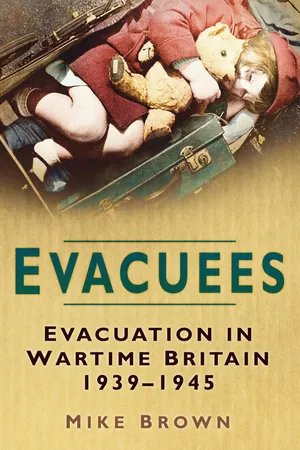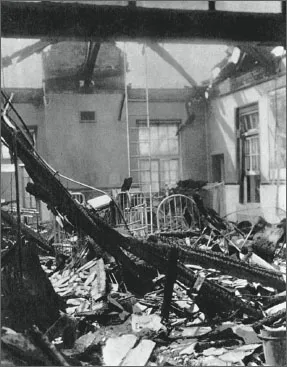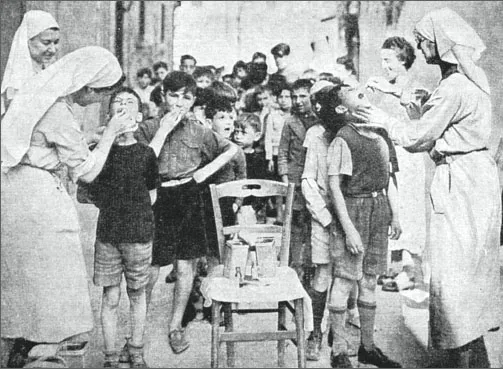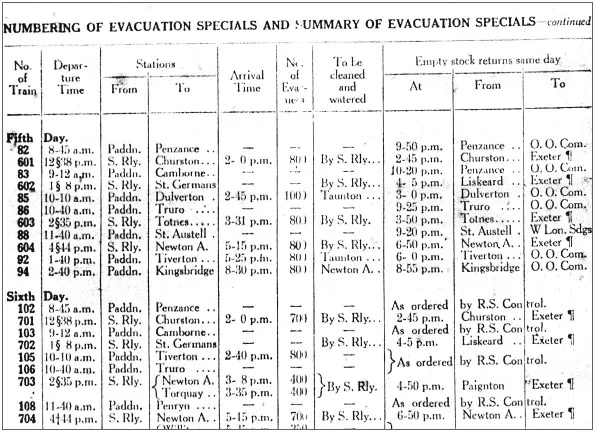![]()
ONE
How It All Began
As with so many aspects of the Second World War, the roots of evacuation can be traced back to the First World War. The first air raids on Britain began as early as 1914, with London being bombed for the first time in May of the following year. During the course of that war, fourteen hundred civilians were killed in just over one hundred raids, first by Zeppelins, then by heavy bombers. The citizens of Britain, generally secure from enemy action for almost a thousand years, now found themselves vulnerable, and became more so with each advance in aviation technology, in an inter-war period marked by record-breaking long-distance flights by such people as Charles Lindbergh, Amy Johnson and Amelia Earhart, and air races, such as the Schneider Trophy.
Less than three years after the signing of the Versailles Treaty the Air Raid Precautions, or ARP Committee was set up to examine the problems posed by air raids. Included in the topics for discussion suggested by the chairman, Sir John Anderson, at its first meeting in May 1924 was the possible evacuation of sections of the civilian population. The committee’s earliest investigations into ‘evasion’, or evacuation as it came to be known, hinged on the premise that London, as the capital, would be the principle target of air attacks. The ARP Committee’s first report in December 1925 established two basic points:
1)that it would be impossible to relocate most of the activities normally carried out in London, and
2)that the nation could not continue to exist if bombing forced these activities to cease.
The committee pointed out the disastrous effect that heavy civilian losses could have on the country’s morale, and that in a democracy, curbs on the movement of private citizens could not be too widesweeping. It therefore proceeded to separate the population into two groups; those involved in vital work, and those whom they described as les bouches inutiles, i.e., those who played no direct part in essential war work especially women, children, the aged, and infirm. This group should be encouraged and helped to move. The committee realised that this would require a great deal of planning, and it was therefore proposed that schemes be drawn up by the Ministries of Health and Transport and the Boards of Education and Trade. The schemes needed to concentrate on the poorer districts of the capital, as wealthier families would be able to arrange to evacuate themselves. Some committee members were also of the opinion that the ‘foreign, Jewish and poor elements’ who lived in the poorer areas would be likely to panic once bombing started, and should be evacuated as soon as possible to prevent them undermining morale. If this was not enough, they also believed that after bombing the poor would ‘flock’ to the wealthier areas and loot them wholesale. The Office of Works, it was suggested, should be instructed to make plans for the removal of artworks, national treasures, and historic and vital records to places of safety – safe, not only from bombing, but also, presumably, from being looted by the poor! This early work established basic principles upon which all later schemes were founded, the most important conclusions being that evacuation was desirable, that it should apply to specific groups, and that it should be voluntary.
By 1930, the main plan for civilian evacuation still presumed that the centre of London was effectively the only danger area. In this scheme, the London Underground would be the main vehicle for transporting thousands of Londoners to the outskirts of London and, it was assumed, safety. There were no plans as to what these ‘evacuees’ would do once they got there.
In 1931 another committee was set up, under the chairmanship of Sir Warren Fisher, to look into ARP services. Committee members were told by their experts that, in a future war, 600 tons of bombs per day could be dropped on Britain, following a huge opening assault dropping 3,500 tons in the first 24 hours causing 60,000 dead and 120,000 wounded on the first day, followed by 66,000 dead and 130,000 wounded per week thereafter. These figures led them, inevitably, to the conclusion that evacuation would play a vitally important role in any defence scheme, and they began close examination of the problem of evacuating 3½ million citizens from various parts of London. However, the findings of this committee, reported in 1934, were somewhat overshadowed when the scope of the ARP was enlarged to include not just London but the country as a whole in 1934/5. This latter move culminated in the formation of the ARP Department of the Home Office.
Life, and death, in the city: a children’s hospital ward in Belfast the morning after a raid. (HMSO)
The idea of evacuation was certainly not unique to Britain, and other countries were pushing ahead with their plans; the French Government, for instance, issued a handbook on evacuation in 1936 setting out their scheme. All non-vital civilians would be encouraged to leave the towns; those closely related to people who needed to stay behind would be evacuated to places nearby, while those who had to remain would be evacuated each night. The mayor of each town would be responsible for the evacuation of his town, and for liaison with surrounding villages as to billeting. People were to be evacuated by trains, trams and buses, and all villages and towns were expected to accept a number of evacuees equal to their population.
French evacuation: Parisian children undergoing medical inspection on arrival at their new billets, September 1939.
For the next few years evacuation plans progressed slowly in Britain. Some work was done on a London evacuation scheme but the 1937 government booklet The Householder’s Handbook, updated in 1938, gave only one suggestion as to what to do if war threatened: ‘If you live in a large town, children, invalids, elderly members of the household, and pets, should be sent to relatives or friends in the country, if this is possible.’ As with other civil defence measures, the onus was placed on individuals to make their own arrangements.
In spite of optimistic statements by the Home Secretary, Sir Samuel Hoare, government plans for large-scale evacuation were still in a very rudimentary state by early 1938. In the Home Office air raid scheme issued to the county boroughs in March of that year, the paragraph on evacuation read: ‘To be completed as and when further directions are given by the Secretary of State.’ An accompanying circular instructed local authorities to take no action until specific instructions had been received from the Home Office.
On 26 May 1938 the Home Secretary announced that he had set up the ‘Committee on Evacuation’, made up of four MPs under Sir John Anderson. They met for the first time on the following day, when they agreed to look at foreign schemes. Meanwhile, it was widely accepted that the evacuation of children should form the most important part of any scheme, and would also be the easiest to organise. J.B.S. Haldane, in ARP, noted that: ‘There is one class of the community which could be evacuated at very short notice, and with very little difficulty. These are the school children, and particularly the elementary school children. They are accustomed to obey their teachers, at least up to a point.’ One of the many proposals put to the Anderson Committee was for the erection of 600 camp schools in rural areas, each to house 500 children, with foundations laid for other huts (stored in sections) so that the population of each camp could be increased to 5,000 in the event of an emergency. Each camp would be allocated to ten elementary schools that, in peace time, would use the camp in rotation, for one month each. In the event of war all ten schools could be evacuated to the camp, with the advantage that they would already know the camp and the surrounding area.
By this time, the government was under continued pressure to come up with definite plans. When questioned in Parliament about evacuation on 1 June 1938, the Home Secretary, was still vague: ‘That question raises so many issues that although we have plans prepared in outline, I should be very loath to decide upon any one of them until I felt that there was general body of public opinion outside behind it.’ The Anderson Committee reported back to the Home Secretary before the end of July, concluding that: ‘The whole issue of any future war may well turn on the manner in which the problem of evacuation from densely populated industrial areas is handled.’ While agreeing with the findings of earlier committees, the Anderson Committee further proposed that arrangements for the reception of refugees should rest primarily on accommodation in private houses under compulsory billeting powers, with the initial cost being borne by the government, though ‘refugees’ able to do so should later be required to make some contribution. Detailed plans should be laid to evacuate schoolchildren, with the consent of their parents, school by school, in the charge of their teachers and at government expense. Such a scheme, concluded the committee, could be organised within a few months, and it pressed for central and local organisations to be set up to carry out the required planning, beginning with the education of the public on the necessity for the scheme.
Here, then, for the first time, the committee had started to address the two problems that earlier schemes had failed to do: 1) what to do with the evacuees once they were out of the cities; and 2) in a voluntary system, how to encourage people to leave. Many saw these, correctly, as it turned out, as the greatest problems for any plan – they would never be completely solved. J.B.S. Haldane argued from his experiences in Spain that: ‘People are only willing to leave their homes after so much bombing that transport is partially paralysed, and they are only willing to give full hospitality as honoured guests to their starving and lousy fellow-countrymen after they have learned patriotism.’
On 18 June 1938 the Women’s Voluntary Service (WVS) was formed, primarily for recruiting women to the Civil Defence Services. However, from the very first the WVS proved adept at turning its hand to any necessary task and in July its founder, Lady Reading, addressed a secret meeting at the Girl Guides’ Headquarters where she asked for the names of Guiders prepared to take responsibility for local evacuation arrangements, backed up by the WVS. Next, the support of the Women’s Institutes (WI) was secured, and a WVS Evacuation Committee was set up that included representatives of the WI and the Guides. They then appointed a County Evacuation Officer in every county likely to receive evacuees.
Early in September 1938, with the Munich Crisis brewing, the Committee for Imperial Defence accepted the Anderson Committee’s proposals.
![]()
TWO
Planning and Rehearsal
In September 1938 Britain found itself on the brink of war. Germany laid claim to a part of Czechoslovakia, the Sudetenland, which lay along their joint border; the Czechs dismissed their claim. Both countries prepared for a war into which France and Britain would be drawn by treaty commitments. Defence measures were rushed forward. On the basis of the Anderson Committee report, a scheme, later to become known as Plan 1, was hastily patched together for the evacuation of London children. On 22 September a special conference was held at Chelmsford, where Essex towns were asked to take their share of the 2 million people expected to be evacuated from the capital. This included almost 45,000 to be transferred to the Colchester area, to arrive over a five day period at a rate of nine train loads per day. Four days later, the Government asked the WVS to help every local authority in the reception areas to carry out a house-to-house census of accommodation likely to be available for evacuees (in some places this job was carried out by the Women’s Institutes). The survey found almost 5 million spare billets in the reception areas, in most of which the WVS set up an evacuation committee, working with the Local Authority’s Chief Billeting Officer, to coordinate the work of reception and billeting.
A letter dated 27 September 1938, setting out the items that the boys of Brockley Central School, South London, should bring with them for evacuation. Notable among the items of food are two boiled eggs and (presumably to counter their effect) twelve prunes.
At the height of the crisis on Thursday 29th the Government published its plans for the assisted evacuation of 2 million people from London, one quarter of them schoolchildren. Already many were moving themselves and their families away from the main cities, the railways reporting passenger numbers of Bank Holiday proportions, with Wales and the West Country as favourite destinations. The Government’s plans were to commence the following day, the 30th, with the evacuation of half a million London schoolchildren. In Europe, however, the Munich Agreement, handing over the Sudetenland to Hitler, was signed that day, and the evacuation scheme was called off at the last minute, much to everyone’s relief, for the scheme was nothing if not rudimentary. But 4,000 children from nursery and special schools had already been evacuated by ambulances to schools and camps in the countryside – they were all back home by 6 October, but the experience gained proved indispensable for later plans.
A Great Western Railway evacuation train schedule. It all seems very well organised, but in reality schools on their arrival at stations were put on the first train available, which was often not the train on which they were due to travel.
Caroline Williams was at teacher training college in London at this time:
In September I returned to St Gabriel’s College in Camberwell. Immediately we were overwhelmed by the Munich Crisis and our principal decided to send us home but asked if any of us would volunteer to act as escorts to a nursery school in the Mile End Road, before we finally went home. With two other students I started off from the Nursery in a coach with the Nursery staff, and the children, plus potties – destination unknown.
We eventually arrived in Aylesbury, Bucks. It must have been on the green of a housing estate where we were finally unloaded from the coach. The local mothers stood around and began to choose the children, ‘I’ll have that one’, ‘I’ll have that one’, I heard as we stood looking on. A woman asked us, ‘Are you teachers?’ We told her we were students and would be travelling to our homes the next morning and she hastened to offer to put us up for the night, probably relieved at the outcome.’
W.G. Eady, Deputy Under Secretary of State at the Home Office, later said that the scheme would ‘just about have stood up to the requirements of getting refugees out of London and bedding them down that night while we tried to sort out what was going to happen afterwards.’
A post-mortem of the experiences of th...




